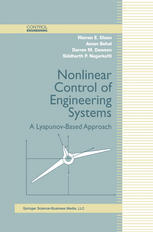

Most ebook files are in PDF format, so you can easily read them using various software such as Foxit Reader or directly on the Google Chrome browser.
Some ebook files are released by publishers in other formats such as .awz, .mobi, .epub, .fb2, etc. You may need to install specific software to read these formats on mobile/PC, such as Calibre.
Please read the tutorial at this link: https://ebookbell.com/faq
We offer FREE conversion to the popular formats you request; however, this may take some time. Therefore, right after payment, please email us, and we will try to provide the service as quickly as possible.
For some exceptional file formats or broken links (if any), please refrain from opening any disputes. Instead, email us first, and we will try to assist within a maximum of 6 hours.
EbookBell Team

5.0
60 reviewsRecent advancements in Lyapunov-based design and analysis techniques have applications to a broad class of engineering systems, including mechanical, electrical, robotic, aerospace, and underactuated systems. This book provides a practical yet rigorous development of nonlinear, Lyapunov-based tools and their use in the solution of control-theoretic problems. Rich in motivating examples and new design techniques, the text balances theoretical foundations and real-world implementation. Features include: * Control designs for a broad class of engineering systems * Presentation of adaptive and learning control methods for uncertain nonlinear systems * Experimental testbed descriptions and results that guide the reader toward techniques for further research * Development of necessary mathematical background in each chapter; additional mathematical prerequisites contained in two appendices Intended for readers who have some knowledge of undergraduate systems theory, the book includes a wide range of applications making it suitable for an extensive audience. Graduate students and researchers in control systems, robotics, and applied mathematics, as well as professional engineers will appreciate the work's combination of theoretical underpinnings and current and emerging engineering applications.